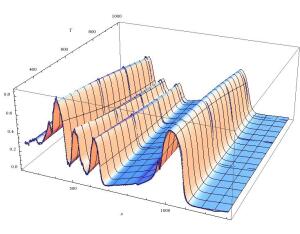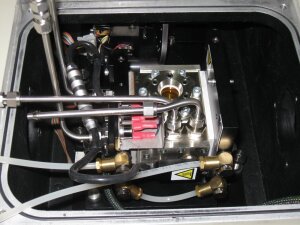High-T Optical Constants
3D-Plot of the temperature development of the reflectivity of an oriented olivine crystal (measured with polarized ligth along the crystallographic a-axis)
Grafik: AIUIn one of our most recent projects we are calculating the high temperature optical constants of different kinds of cosmic dust analogs. The temperature has a big influence on the absorption/emission behavior of matter. Especially for crystaline materials, which seem to exist mainly in dust disks around stars and in planetary systems, the temperature dependence can cause severe changes in the resulting spectra, which affects the analysis of astronomical spectra of dust disks around young stars. Here the knowledge of the particular constitution of such dust disks is a key factor for understanding the processes in young solar-like systems, which is on of the aims of the priority programme (SPP) No. 1385 "The First 10 Million Years of the Solar System - A Mineralogical Approach" of the DFG (Deutsche Forschungsgesellschaft) from which this project is financially supported.
HTHP-cell in our Bruker spectrometer
Foto: AIUFor calculating the optical constants, we are first measuring the reflectance depending on the wavelength. For simulating the high temperatures we are using a special accessory for our FTIR- spectrometer BRUKER 113v, a High-Temperature-High-Pressure-cell (HTHP-cell). With this cell and the spectrometer we are able to perform in-situ mearurements of infrared reflectance spectra on different materials at temperatures up to 800°C. The optical constants n,k (the real and the imaginary part of the complex refractive index) are then calculated by fitting the reflectance data with a Lorentzian oscillator model.
Project Team: Simon Zeidler, Harald Mutschke, Gabriele Born, Thomas Posch (Vienna)

